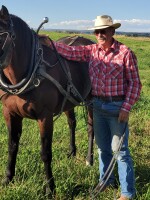This is Bob Bragg with the Farm News & Views Report for the first week of April.
Over the past nine weeks or so since a new administration took over in Washington D.C., the stock markets have taken a beating, with the Standard & Poors 500 market index down about 10% from mid January. The agricultural economy has also been affected, with declines in many commodity prices, like soybeans, corn, cotton, wheat and pork setting at prices that are 5% to 8% lower than were in early January. But we probably should be alarmed about potential long term consequences of cutting agricultural programs and policies. Ever since Abraham Lincoln established the U.S. Department of Agriculture in 1862, the Agency has championed agricultural research, but now, research is being severely hampered by the current administration, and scientists are concerned that both agricultural producers and the general public will be impacted by these budget cuts. For example, the threat of a New World screwworm outbreak in U.S. domestic livestock herds would be substantial, because before its eradication 1966, this pest cost the U.S. livestock industry more than $100 million annually because it caused the death of thousands of cattle and sheep. This pest has recently reemerged in Mexico, and there is the possibility that it will move north again. So, the recent termination of many of the 5,300 grants to the U.S. Agency of International Development, that included animal disease monitoring projects for containing avian flu, the New World Screwworm in Central America, and combating the deadly African swine fever, which if it were to be introduced into the U.S. could spread like wildfire through both domestic and feral hog populations, decimating U.S. pork production while also preventing U.S pork from being sold to the rest of the globe. Another abandoned program is the USDA’s Sustainable Agriculture Research and Education grants program, which supported small scale research and outreach in agroforestry and agricultural production, largely by individual farmers, who have been left to absorb the costs they incurred while conducting their research for the USDA. Therefore, axing research funding might well lead to some serious unintended consequences.
We often consider that farm and ranch businesses are completely different farm non-farm entities, but Farm Business Management Educator, Garen Paulson, provides some tips for agricultural producers that are also applicable to non-farm business. He points out that most profitable farmers keep detailed financial records, so that they can track how their businesses are doing at any time of the year. These records should include balance sheets, income statements, and a break-even analysis on each enterprise, so that the information can be used for marketing and cost control. He also recommends that farmers manage debt loads, because he has observed that low profit farmers had higher debt loads than the more profitable producers. Another suggestion is that since farm and ranch families are so closely tied to the business, family living expenses should also be tracked.
As the calendar rolls into April, it’s not too late to take soil samples in pastures, hay fields and gardens and submit them to a soil test laboratory. Unless you’re sampling large farm fields, the process can be completed in less than an hour or so. Local Cooperative Extension offices in the Four Corners Region will have instructions for completing the samples, bags to put the samples into, and information about where to send the sample for analysis. Putting the right amount of fertilizer onto a crop helps to return optimal yields.
Will Rogers wrote, “Never let yesterday use up too much of today.”




